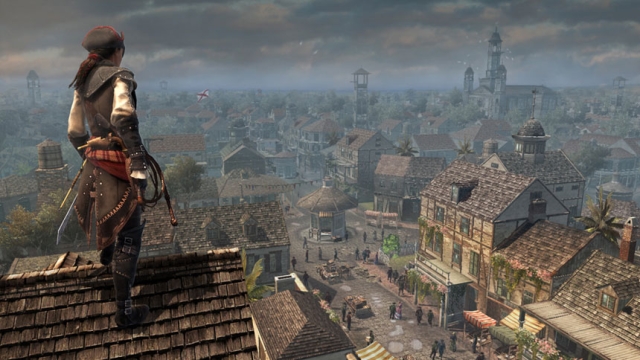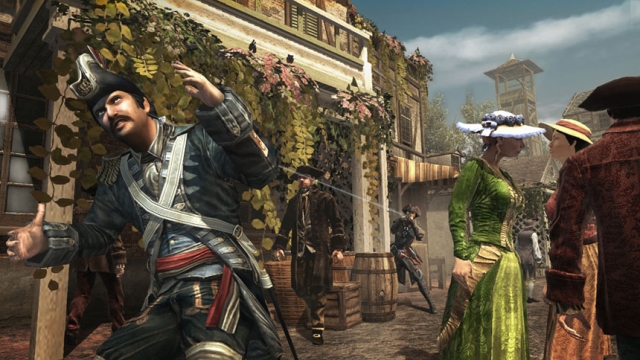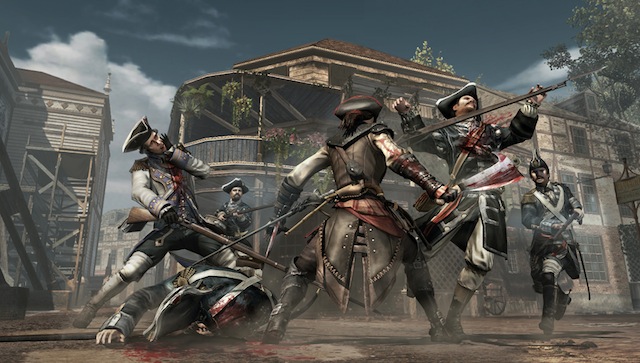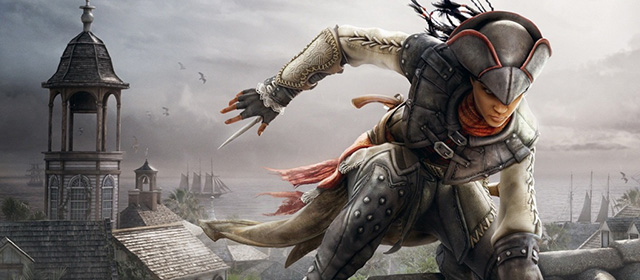For the first time, Assassin’s Creed makes its way to a portable device in an undiluted format. Offering a brand new character and a setting that is different to Assassin’s Creed III, but connected to it at points; thanks to Ubisoft Sofia, you too can have a tiny Assassin in your pocket, at all times.
Set between 1765 and 1780, you play the role of Aveline de Grandpré, the series’ first female lead. A woman of African and French descent at a time of widespread slavery and prejudice, she finds herself in a position of wealth thanks to a cultural practice known as plaçage. At the beginning of the game, we see Aveline as a child when her mother goes missing in the town of New Orleans, fast forward and Aveline is a grown woman, living with her French father and stepmother and assisting with the family import/export business, while leading a second life as an Assassin.
How or why Aveline becomes an Assassin is unclear, which seems to be a recurring problem with Liberation’s narrative. The setting, characters and political/cultural climate are ripe for a mature story, one that would be incredibly ambitious for a portable game, but, for some reason, Ubisoft Sofia have half-assed everything interesting about the story, with the game feeling like entire chunks of narrative are missing; which, in some cases, is actually intentional.

The game is once again framed around the Animus, a machine that allows you to relive the past lives of others, but with an incredibly interesting difference. Before the game even loads, you are advised that the game is from Abstergo, the fictional Big, Bad Corporation of the Assassin’s Creed universe, and that this is a simulation offered up from them as an entertainment device for consumers. Early on in the game, you experience someone hacking into the simulation, offering you the chance to see the real truth behind the events by assassinating specific citizens to unlock extended versions of the in-game cutscenes. Finding all six of these “Citizen E’s” are the only way to experience the game’s true ending.
Sadly it’s a brilliant plot device that has been squandered by not going far enough with it. The idea of Abstergo providing a propaganda-laced simulation of Assassin events is one that gushes with potential, but like Liberation’s narrative in general, it’s missing too much to be interesting. It’s worth noting that the entire game is set in the past; there are no modern day sections featuring Desmond or his posse.
Put simply, Liberation is a very good looking game. The assets and environments are well designed, with great animation and graphical effects that look beautiful, even though the game does have a case of the jaggies. The only problem with the game looking so good, is that that the framerate becomes very erratic as a result. It didn’t detract from my experience with the game, but it was noticeable. I would have preferred a simpler looking game with a more consistent framerate, but it’s not a showstopper.
Something you can always expect from an Assassin’s Creed game is dialogue, and lots of it. Liberation is no exception, with most, if not all, of the game’s narrative expressed in spoken dialogue. Although most of this dialogue appears to have been recorded at a noticeably low bitrate, so it doesn’t sound as crystal clear as you would expect from the main games; this is probably due to space constraints, and is a minor quibble.

In terms of music, each of the game’s three locations have their own suitable background music, and the original compositions fit well with the action while still keeping in the same sort of musical style as previous games in the series.
Liberation is built using the same AnvilNext engine as the recently released Assassin’s Creed III, so you are basically playing a portable Assassin’s Creed game. The game’s three primary locations (New Orleans, The Bayou, Chichen Itza) provide plenty of buildings or treetops to freerun though, and traversing these landscapes work in the game way as Assassin’s Creed III. The mission structure is exactly the same as other Assassin’s Creed games, in that it’s split up into “sequences” with side missions also available. The game plays like an Assassin’s Creed game should, and that is a great achievement for a portable system.
Understandably, Ubisoft Sofia wanted to add some sort of PlayStation Vita-specific functionality to the game, and there are a couple of instances in which it works wonderfully; you are able to view the map by touching the minimap in the bottom-left of the screen, or change weapons by touching the weapon indicator in the bottom-right, for example. Eventually you also earn the ability to Chain Kill, and by pressing right on the D-Pad, the action freezes, and you can touch up to four foes before pressing the X button, prompting a cinematic cutscene of Aveline killing all of those enemies.
However, it’s the other Vita features that will infuriate and annoy. Pickpocketing becomes an almost impossible endeavour as you target an enemy and slowly run your finger up or down the rear touchpad for 15 minutes, while the game decides whether or not it will let you pickpocket your target. A few set pieces require you to control a canoe or horse carriage and use the touchpad as a paddle or accelerate control, which is as painful as it sounds. Sometimes during the game you will be required to physically open received letters by pinching the top of the Vita in-between your thumb and index finger, to “tear” the envelope open, which works, but acts as a completely pointless addition.
The worst crime against video game design occurs during the occasional moment where the game asks you to point the Vita camera at a bright light source, to view a secret message hidden in some letters. I shone the Vita at the Sun, and it still wasn’t bright enough to read the message. After 10 minutes of holding my Vita up to the sky and looking like a pleb, I managed to get it working by turning my mobile phone onto its full brightness, and pointing the Vita at that. Which still took several minutes to detect the light.

Another new feature that Liberation brings to the table, are Personas. Aveline is able to wear three disguises; Lady, Assassin, and Slave, each with their own abilities and limitations. However, there’s never any reason to choose a particular Persona, other than when the game forces you to be one. You’ll want to either be the Assassin or Slave, as the Lady moves so damn slow, and is unable to climb buildings.
But despite those terrible and half-assed design choices, Liberation is an enjoyable game that is well suited to playing on the go. Missions are short enough to be finished in a few minutes, and cutscenes are never too long, so you are never far from getting straight to the action. There is certainly a greater emphasis on being stealthy than in recent Assassin’s Creed games, which is always welcome.
Yes, Assassin’s Creed: Liberation does have a online multiplayer mode. Unfortunately, it plays like a Facebook game where you must pick a side (Assassins or Abstergo) and play a Risk-style game of attacking and defending nodes around the world. Which would be OK if it wasn’t for the fact that the mode’s tutorial is absolutely useless at actually explaining what the hell you are supposed to do, let alone why you are doing it. Ubisoft Sofia shouldn’t have bothered, to be honest.
Like any Assassin’s Creed title, there’s a lot of gameplay to be had. There are eight “Sequences” in the game that will take you around 10-12 hours to finish, plus a multitude of side-missions and collectables to occupy yourself with in-between; so make that around 15-20 hours of gameplay (and more, if you can get your head around the Multiplayer mode).
VERDICT: Liberation is the type of game the PlayStation Vita is crying out for right now. It really is a proper Assassin’s Creed title that can be played anywhere. It’s just unfortunate that the gameplay is filled with some baffling design choices and terribly implemented rear touchpad/camera functionality. With a bit more thought put into the narrative and Vita functionality, this could have been an important “killer app” for PlayStation Vita. If you can stomach these distractions though, there is a solid game here, and for Assassin’s Creed fans, or those looking for a meaty single-player portable Vita title, you could do far worse then this slice of history.






